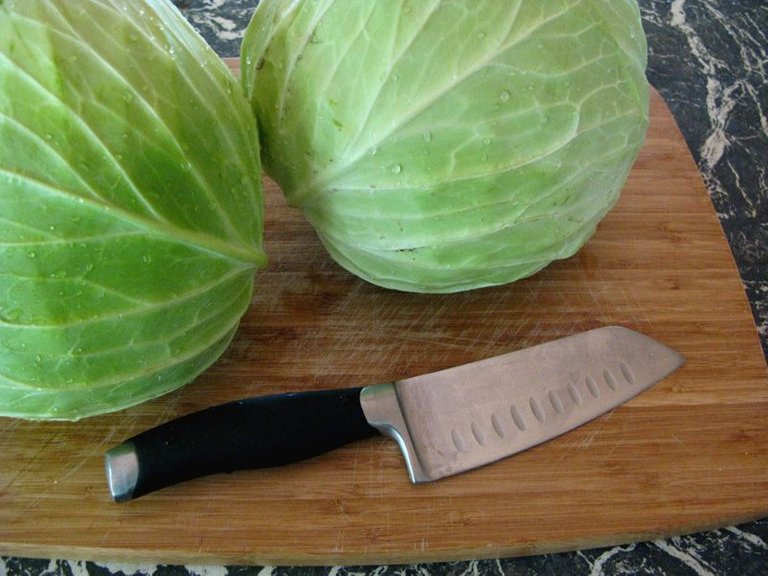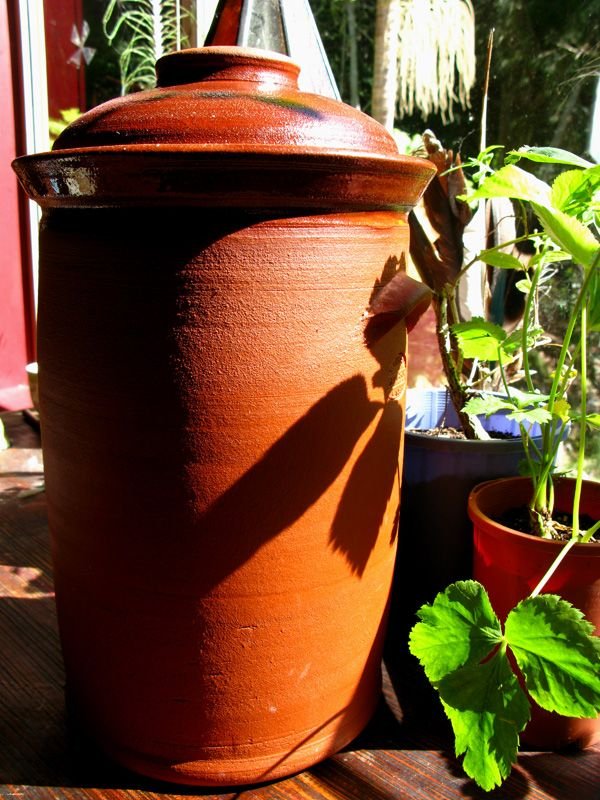
There are plenty of ordinary sauerkraut recipes floating around, but this recipe of basic cabbage and salt kraut with no additions will set the record straight. I give you a very quick overview of the fermentation process of sauerkraut, and begin with the all-important optimal salt to cabbage ratio for a safe and successful ferment. For more detailed information, please see my book.
The optimal salt to cabbage ratio for a crunchy and massively probiotic rich sauerkraut is 11 g salt per 1000 g of cabbage, and this is roughly the average for kraut production in Germany. 11 g is about two slightly rounded tsp of coarse-ground salt, or two tsp of finely ground salt. 11 g/1000 g gives a brine strength of about 2%, and this is what we want if for some reason (e.g. older cabbage) there is not enough brine to cover the cabbage after we have massaged and compacted it. To make a 2% brine, add one tsp of salt to a 250 ml cup of water. The average for production in the US is about 17 g salt/1000 g cabbage, which takes us close to a 3% brine solution strength. We don’t want to go any higher than this though, because once past the 3% mark, tertiary bacterial species are favoured, and this fundamentally bypasses the first two stages of fermentation. Recipes that call for 25 g salt/1000 g cabbage and above should be avoided because this sets an initial pH which may favour some pathogenic species over the desirable species we wish to invite to flourish. The same is true of too little salt – avoid using less than 8 g salt/1000 g cabbage.
There are four stages to a correctly set sauerkraut ferment. In stage 1, enterobacteria, including probiotic strains of E. coli work to consume any residual oxygen, and to acidify the environment to suit the species that will dominate in stage 2. Stage 1 may last from 12 hours to 3 days. Stage 2 bacteria, including Leuconostoc mesenteroides and Lactobacillus brevis further acidify the environment, but while stage 1 bacteria are aerobic (use oxygen), all other species in the following stages are anaerobes (don’t need oxygen). Stage 2 lasts from about 10 – 14 days, after which stage 3 species dominated by Lactobacillus plantarum work to further increase acidity (or lower pH) until after about 3 weeks, the pH has dropped to around 4.1 – 3.8. A final week of stage 4 fermentation follows, where L. brevis and other bacteria capable of consuming the remaining complex sugars get to work. By the end of stage 4, we can expect a pH as low as 3.4. The stages are affected by ambient temperature – slower fermentation in cold weather, more rapid fermentation in warmer weather – and the ideal temperature range to complete all four stages in 6 weeks is 15 - 20° C.

Basic Sauerkraut
1000 g of shredded, white cabbage
11 g of salt
Shred the cabbage to the preferred size, add to a large bowl, and then add the salt. Massage the salt in well, rubbing and wringing and squeezing the cabbage to break down the cell walls. The salt will draw out the moisture of the cabbage as we ‘bruise’ it, and open it up. When we can pick up a handful of cabbage and squeeze it so a good stream of moisture is expressed, we have massaged enough. Don’t forget to put love in the food as you work if the thought of energetically enhanced food appeals to you.
Pack the cabbage down into your fermenting vessel as tightly as you can. Use your hands or a tool – purpose-built kraut pounders can be purchased or made (often out of an old rolling pin with one end cut off and sanded smooth). Wooden spoons or sanded dowel rods may also be used. Express all the air out of the cabbage as you pack. We want no air bubbles at all if we can help it. Leave enough room in the jar to allow for expansion of the cabbage (by trapped CO2), 35 – 40 ml (about an inch and a half) for a jar, 50 ml (2 inches) for a crock. Ideally the headspace is measured from the top of your weight, which is covered by brine. Use the outer cabbage leaves as a cap, whole leaves layered in a crock, rolled up leaves for a jar. Top this with your food safe weight, best materials are good quality glass or ceramic (no external paint or metallic leaf), but food safe hardwoods and boiled and scrubbed smooth, hard, non-porous river stones are also used. I personally do not use metal or plastic – the metal can corrode in the acid, and the plastic can leach toxins and oestrogen-like compounds into your food, but this is a judgement call for each individual to make. Place the lid on your fermenting vessel, then put in a safe place for six weeks.
We really want a crock with a water moat, or a jar with an airlock. Oxygen is not required for fermentation, and carbon dioxide is a by-product of it, and this needs to be able to escape. Allowing oxygen into the ferment creates ideal conditions for mould and kahm yeast formation. Mould has the potential to impact our health substantially, and kahm yeast, while harmless, will impart a rank taste to the ferment. Avoid these by excluding oxygen. Our cabbage wants to be chemical free, as does our water, and our salt wants to be pure, without any additives. Sea salt, or good rock salt are ideal. Common table salt is not suitable.

Equipment needs to be clean or sterile. I use clean equipment for ferments for my own use, and sterilised equipment if the ferment is destined for other people.
More detailed information can be found in my book here: https://gumroad.com/l/bgbrL#
My book on healing and repopulating the gut is here: https://gumroad.com/l/RsLZ#


Bio
Tom Rothsey is an ecologist, environmental scientist, reflexologist, energy worker, health and lifestyle coach, writer, researcher, and teacher of the fermented arts in all their forms. He lives with his wife Christy Lavers, and their son Jasper Blue in a pole house, in a rainforest in North Eastern New South Wales, Australia.
Links
https://facebook.com/celestialroots
http://www.celestialroots.com/
http://celestialroots.tumblr.com/
https://twitter.com/celestialroots1
tom@celestialroots.com
https://steemit.com/@celestialroots
https://mewe.com/profile/589a385be61a4009c926c504
©Tom Rothsey 2018
WARNING - The message you received from @hendraman56 is a CONFIRMED SCAM!
DO NOT FOLLOW any instruction and DO NOT CLICK on any link in the comment!
For more information, read this post:
https://steemit.com/steemit/@arcange/phishing-site-reported-autosteem-dot-info
If you find my work to protect you and the community valuable, please consider to upvote this warning or to vote for my witness.
Hi! I am a robot. I just upvoted you! I found similar content that readers might be interested in:
http://www.celestialroots.com/basic-sauerkraut.php
Whatta crock! Only in this instance that comment is a positive affirmation of the equipment in your photo.
I appreciate your information as it reinforces the adage, "Give a man a fish and you feed him for a day. Teach a man to fish, you feed him for a lifetime." In an era where self-sufficiency is becoming critical, your valuable and easy to follow guidance is so beneficial and very helpful. Thank you for taking time...